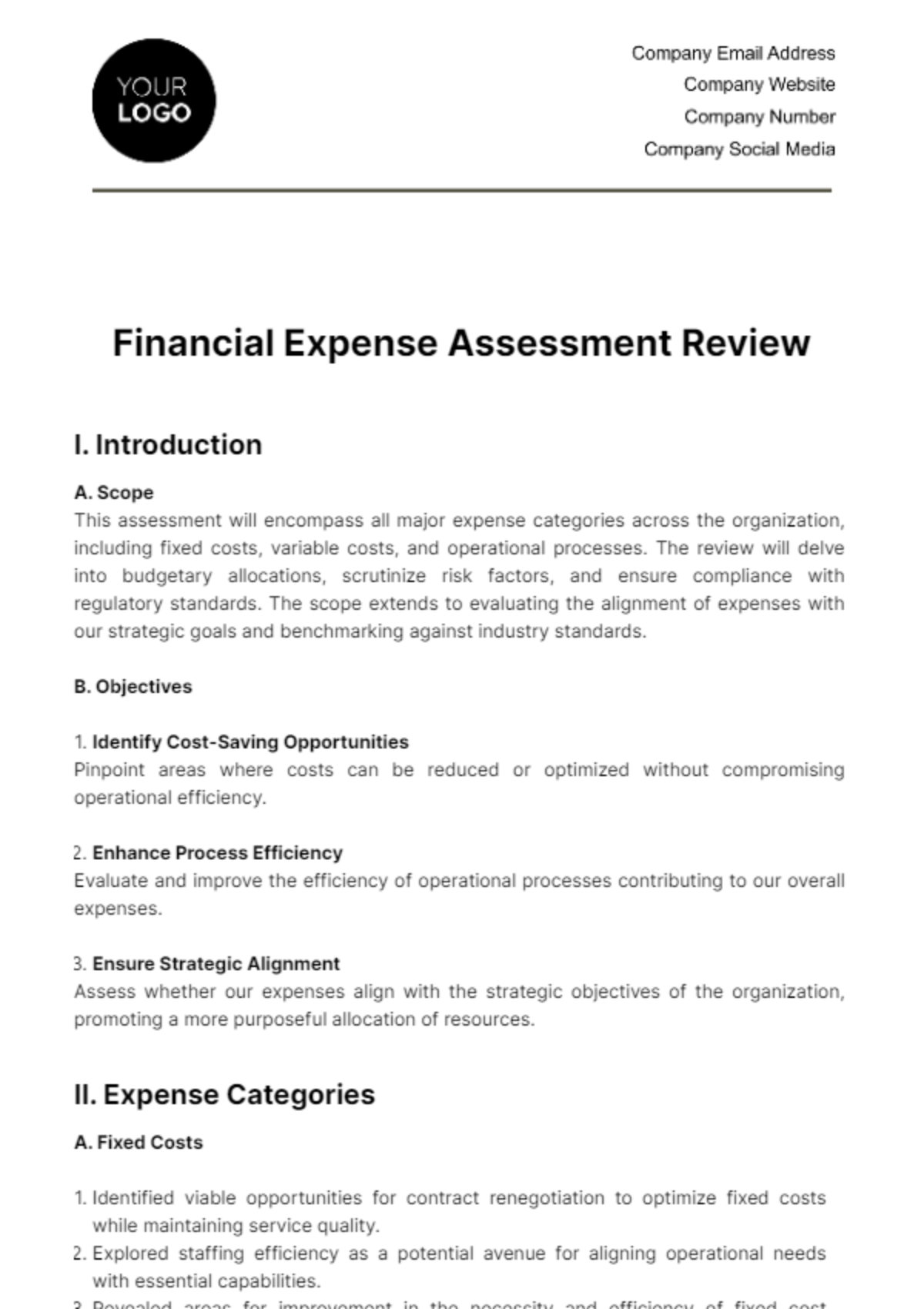Free Financial Expense Assessment Review

I. Introduction
A. Scope
This assessment will encompass all major expense categories across the organization, including fixed costs, variable costs, and operational processes. The review will delve into budgetary allocations, scrutinize risk factors, and ensure compliance with regulatory standards. The scope extends to evaluating the alignment of expenses with our strategic goals and benchmarking against industry standards.
B. Objectives
Identify Cost-Saving Opportunities
Pinpoint areas where costs can be reduced or optimized without compromising operational efficiency.
Enhance Process Efficiency
Evaluate and improve the efficiency of operational processes contributing to our overall expenses.
Ensure Strategic Alignment
Assess whether our expenses align with the strategic objectives of the organization, promoting a more purposeful allocation of resources.
II. Expense Categories
A. Fixed Costs
Identified viable opportunities for contract renegotiation to optimize fixed costs while maintaining service quality.
Explored staffing efficiency as a potential avenue for aligning operational needs with essential capabilities.
Revealed areas for improvement in the necessity and efficiency of fixed cost expenditures, suggesting potential for cost-effective operational adjustments.
B. Variable Costs
Analyzed the correlation between production levels and variable costs, uncovering opportunities for more efficient cost management.
Highlighted the need for a flexible approach to variable costs during varying workloads to optimize expenditure.
III. Operational Processes
A. Process Efficiency
Mapped operational processes, revealing bottlenecks and inefficiencies; suggested areas for process redesign.
The analysis emphasizes the importance of addressing inefficiencies to improve overall process efficiency.
B. Resource Allocation
Evaluated current resource allocation across departments, revealing opportunities for optimization.
The assessment underscores the need to strategically reallocate resources for enhanced organizational efficiency.
IV. Budgetary Analysis
A. Budget Adherence
Actual expenses closely aligned with the budget, indicating effective financial planning.
Minor variances observed, well within acceptable thresholds.
B. Variances Identification
Specific variances identified in certain expense categories like utilities and travel.
Further analysis needed to understand contributing factors.
V. Risk Assessment
A. Identified Risks
Certain expenses are susceptible to external factors like market fluctuations and regulatory changes.
Vendor dependency in critical areas poses potential risk to cost stability.
B. Mitigation Strategies
Explore hedging mechanisms to mitigate impact of market fluctuations on certain expenses.
Diversify vendor relationships and negotiate contingency plans to address supplier dependencies.
VI. Strategic Alignment
The impact assessment affirms that the majority of expenses align closely with the organization's strategic goals.
Areas of discretionary spending, flagged for scrutiny, were found to have varying degrees of alignment with current strategic priorities.
Opportunities for reallocation of resources from non-strategic to strategic areas identified.
The assessment underscores the need to ensure every expense contributes meaningfully to the organization's overarching strategic objectives.
VII. Recommendations
A. Expense Categories
Fixed Costs
Initiate a phased approach to contract renegotiation, prioritizing agreements with higher potential.
Establish clear benchmarks and criteria for service quality to ensure that renegotiations align with organizational standards.
Propose a detailed analysis of staffing levels, considering workload fluctuations and operational demands.
Explore flexible staffing models, such as cross-training, to enhance operational agility while optimizing costs.
Implement identified cost-effective operational adjustments promptly to improve overall efficiency.
Emphasize continuous monitoring and adjustments based on evolving business needs.
Variable Costs
Implement flexible approaches to variable costs in response to varying production levels.
Establish dynamic cost management strategies that align with changing workloads to optimize expenditure.
Propose a proactive supplier relationship management strategy to address potential renegotiation or diversification opportunities.
Encourage regular assessments of supplier agreements to ensure ongoing alignment with cost-effectiveness goals.
Implement operational optimization opportunities identified in the cost-benefit analysis.
Emphasize collaboration between relevant departments to ensure the successful execution of cost-saving measures.
B. Operational Processes
Process Efficiency
It is recommended to immediately implement process redesign in identified areas of inefficiency.
Establish a cross-functional team to oversee and drive the redesign process, ensuring a holistic and collaborative approach.
Explore automation opportunities in processes identified for redesign to reduce manual efforts.
Collaborate with the IT department to assess and implement suitable automation solutions.
Resource Allocation
Consider strategic reallocation of resources.
Establish a resource allocation task force to oversee the process and ensure alignment with organizational goals.
- 100% Customizable, free editor
- Access 1 Million+ Templates, photo’s & graphics
- Download or share as a template
- Click and replace photos, graphics, text, backgrounds
- Resize, crop, AI write & more
- Access advanced editor
Navigate detailed expense assessment with the Financial Expense Assessment Review Template from Template.net! Uncover insights with the intuitive AI Editor Tool, seamlessly integrated into this editable template! Customize it dynamically to achieve a nuanced approach to strategic expense management. Streamline financial decisions with precision with your customizable ally! Download immediately!





























